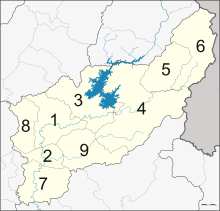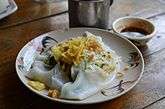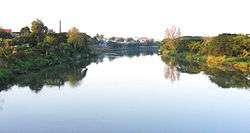Uttaradit Province
| Uttaradit อุตรดิตถ์ | ||
|---|---|---|
| Province | ||
|
Phraya Phichai Dap Hak Monument, in front of Uttaradit City Hall | ||
| ||
 Map of Thailand highlighting Uttaradit Province | ||
| Country |
| |
| Capital | Uttaradit town | |
| Government | ||
| • Governor | Phiphat Ekphaphan (since October 2016) | |
| Area | ||
| • Total | 7,838.6 km2 (3,026.5 sq mi) | |
| Area rank | Ranked 25th | |
| Population (2014) | ||
| • Total | 460,400 | |
| • Rank | Ranked 54th | |
| • Density | 59/km2 (150/sq mi) | |
| • Density rank | Ranked 68th | |
| Time zone | ICT (UTC+7) | |
| ISO 3166 code | TH-53 | |
Uttaradit (Thai: อุตรดิตถ์, pronounced [ʔùt.tā.rā.dìt]) is one of the northern provinces (changwat) of Thailand. Neighboring provinces are (from south clockwise) Phitsanulok, Sukhothai, Phrae and Nan. To the east it borders Xaignabouli of Laos. Uttaradit is 488 km north of Bangkok, and 238 km southeast of Chiang Mai.
History
Uttaradit means the "port of the north" or "northern landing", as it was formerly a trade center on the Nan River.[1]
In the Sukhothai era several city states (Mueang) subject to the king were in the area of the modern province. Mueang Fang was in modern-day Mueang Uttaradit district, Mueang Thung Yang in Laplae, and Mueang Ta Chuchok in Tron district.
During the Ayutthaya kingdom, Mueang Phichai was one of the 16 main Mueang of the Thai kingdom. In the reign of King Naresuan, the ruler of Phichai rebelled, joined by the ruler of Sawankhalok. Their revolt was suppressed and the inhabitants of both cities were forced to move south to Phitsanulok.
Following the fall of the city of Ayutthaya to the Burmese in 1767, Phichai was the site of several battles against the invaders. The ruler of Phichai succeeded in driving back the Burmese and was awarded the title Phraya Phichai Dabhak - the "Lord of Pichai with a Broken Sword", as he had broken one of his swords in fierce hand-to-hand combat with the enemy.
In the reign of King Rama III Mueang Phichai controlled several Mueang of northern Siam like Nan or Phrae, and even Luang Prabang and Vientiane. At the point where the Nan river became shallow a port was established. As this town grew in importance as an important trade point, in 1887 it was made a Mueang subordinate of Phichai. 1899 the center of Phichai was moved to this new location, which was renamed to Uttaradit in 1915.[2]
Geography
The province is in the Nan River valley. About 45 kilometers north of the city of Uttaradit is the Queen Sirikit Dam, which created a 250 km² artificial lake. The Phi Pan Nam Range reaches the northwest of the province.
Most of the province was once covered with teak forests, then the major product of Uttaradit. The largest teak tree in the world is found at the Ton Sak Yai Park in the Luang Prabang Range.[3] The 1,500-year-old tree measures 9.87 m in circumference and 37 m in height. Originally it was 48.5 m high, but it was damaged in a storm.
Three national parks are located in the province—Klong Tron,[4] Lam Nam Nan,[5] and Phu Soi Dao.[6]
Symbols
The provincial seal shows the mondop at the temple Wat Phra Thaen Sila At, in Baan Phra Thaen in the Laplae district. The main item of worship in the temple is a laterite block, which is believed to have been used by Buddha to seek enlightenment. The mondhop is built upon this block.
The seal was first designed in 1940, later a garuda as the symbol of Thailand and the name of the province were added.
The provincial tree is the teak (Tectona grandis).
Administrative divisions

The province is subdivided into nine districts (amphoe). These are further subdivided into 67 communes (tambon) and 562 villages (muban).
Tourism
Sights


Sak Yai (สักใหญ่) At Ban Pang Klua, Tambon Namkrai about 53 km away from the province with an area of about 20,000 rai and consists of various unsorted woods. Most important of all this botanical forest has a biggest teak tree in the world. It has a height of 37 m and a circumference of 9.58 m. It is about 1,500 years old. It was 47 m tall until damaged in a windstorm.[7]
Klong Tron (คลองตรอน) national park has a very natural forest covering areas in Tambon Saentor and Tambon Namkrai of Nam Pat district, Tambon Tham Chalong of Mueang Uttaradit district, Tambon Phaluad of Tha Pla district, Tambon Nam Phi, Tambon Phak Kuang, Tambon Borthong of Thong Saen Khan district in Uttaradit province. Total area is 324,240.80 Rai or about 518.80 km2. It consists of high and low hills.
Phu Miang (ภูเมี่ยง) at Tambon Nam Pai, the Phu Miang mountains divide Uttaradit Province and Phitsanulok Province. They are about 1,656 meters above sea level. At the peak, you can view both provinces and see Sirikit Dam. The Klong Tron waterfall of eight levels is here.
Chan cave (ถ้ำจัน) at Tambon Nam Krai. It is the middle cave of five. The way to the cave is very steep and the cave entrance is semicirclar. Inside is a huge room. The ceiling is about 20 m high and in the middle of the cave a Buddha image is located.
Tao cave (ถ้ำเต่า) at Tambon Nam Krai. It is on another mountain and about 620 m from Tham Chan Cave. From the cave entrance, a walkway has an excavation which looks like a stone sculpture. The way to the cave is a bit complicated; on the left side has a 17 m long hollow being steep until the first room. From here, there is a tiny hole where you can go through. Another room is linked with the right walkway. From here, you can walk to the large room where a six metre high stone pillar is in the middle. In the cave are beautiful stalagmite and stalactites.
Phu Soi Dao (ภูสอยดาว) with an area of 125,110 rai covering Nam Pad district of Uttaradit and Chat Trakan district of Phitsanulok, the park, particularly at the height 1428 metre in Ban Rom Klao, used to be the stronghold of the communists. Located in the mountainous area with over 1,800 meters height above sea level, the topography of the park is like that of Phu Kradung. It is cold throughout the year. Beside interesting natural attractions in the park, carrier and tent are available for tourists.
Phu Soi Dao Waterfall, located near the office of the park, is very shady with trees and plants. The 5 level fall houses a tourist service center, No accommodation, but camping site, is available. From the fall to atop the hill takes about 4 – 5 hrs’ walk.
Sai Tip Waterfall (น้ำตกสายทิพย์) located in the middle of the pinery, is one of the most beautiful falls in the park. It has 7 levels, which can be reached by walking from camping area down to the 7th level, each level is not too high, so high so, tourist can admire the beautiful white and clear water falling down along the rocks, covered with moss and lichen which looks like green velvet.
Wat Thamma Thipatai (วัดธรรมาธิปไตย) is where the door panels of the large and ancient Vihan of Wat Phra Fang are kept. The carved design is of the graceful style of the Late Ayutthaya Period. They are rated as the second best such creation next only to those at Wat Suthat in Bangkok.
Wat Tha Thanon (วัดท่าถนน) houses Luang Pho Phet (หลวงพ่อเพชร), the principal Buddha statue of the province. It is of the Chiang Saen style and cast in bronze.
Wat Yai Tha Sao (วัดใหญ่ท่าเสา) It features and old vihan with beautiful wood-carved door panels and lintels.
The Phraya Phichai Dap Hak Memorial (อนุสาวรีย์พระยาพิชัยดาบหัก) As governor of Muang Phichai (south of Uttaradit) about 200 years ago during the Thon Buri Period, he valiantly fought with Burmese evaders until one of his swords broke in two. But he prevailed. Hence the sobriquet "Phichai of the Broken Sword".
Uttaradit Provincial Cultural Hall (หอวัฒนธรรมจังหวัดอุตรดิตถ์) houses important historical relics. A major item is the "Yan Mat" (ยานมาศ), a carved wooden carrying pole made by late-Ayutthaya Period craftsmen.
Wat Klang (วัดกลาง) is an old temple with beautiful plaster bas-reliefs over the ubosot. Inside are rare wall murals of the Early Rattanakosin Period style depicting the Jataka and assemblage of celestial beings.
The Phra Si Phanommat Memorial (อนุสาวรีย์พระศรีพนมมาศ) commemorates a community leader who was highly revered by the townspeople. The Chinese-born alcohol tax collector contributed greatly to the development of the community and was rewarded with the rank of Phra Si Phanommat from King Rama V.
Wat Phra Borom That Thung Yang (วัดพระบรมธาตุทุ่งยั้ง) An old temple, once called Wat Mahathat. There is a large, circular-shaped, Ceylonese-style chedi enshrining a holy relic.
Wat Phra Yun Phutthabat Yukhon (วัดพระยืนพุทธบาทยุคล) features a Chiang Saen-style mondop which covers a pair of holy footprints. It also houses a Sukhothai-style Buddha statue cast in bronze.
Wat Phra Thaen Sila Art (วัดพระแท่นศิลาอาสน์) The major feature is the base of a sermon platform built with laterite. The square slab with pattern is believed to have been made during the Sukhothai Period.
Namtok Mae Phun (น้ำตกแม่พูล) at Ban Ton Klua, about 20 kilometres from town. The dam-like barrier creates multi-level cascades amid pleasant natural surroundings.
Bo Lek Nam Phi (บ่อเหล็กน้ำพี้) was the source of the best quality iron ore which was used to fashion swords and weapons in the past. Today, there are still two "wells" in existence. Ores from these two sources are believed to have been used to make swords for kings only.
Lam Nam Nan National Park (อุทยานแห่งชาติลำน้ำน่าน) It is a complex mountain range comprising various kinds of abundant forests. It covers a total area of 624,468 rai and consists of mixed deciduous forest, dry evergreen forest, hill evergreen forest and deciduous dipterocarp forest, where the leaves will transform into beautiful colours during winter and is a habitat of various types of animals such as barking deer, deer, wild boars, bears and more than 200 kinds of birds. Sirikit Dam (เขื่อนสิริกิติ์), in the park, is the country's largest earthen dam.
Local Products
Interesting items include woven materials (ผลิตภัณฑ์จากผ้าพื้นเมือง) with their lovely designs and colours, and preserved edibles made from local fruits such as chewy candy-like Kluai Kuan (กล้วยกวน) which is made from banana.
Culture
Festivals

Phraya Phichai Dap Hak and Red Cross Fair (งานพระยาพิชัยดาบหักและงานกาชาด) is organized to commemorate the heroic deeds of Phraya Phichai during 7–16 January every year at Phraya Phichai Dap Hak Stadium. There are the Provincial Red Cross Centre’s booths selling products, traditional and cultural performances, various forms of entertainment and a ceremony to worship Phraya Phichai Dap Hak.
The Tradition of Buddha Cremation (ประเพณีถวายพระเพลิงพระบรมศพพระพุทธเจ้า), a religious ritual seen nowhere else, is held at Wat Phra Borom That Thung Yang after Visakha Bucha day in May. It features the re-enactment the funeral ceremony for the Lord Buddha.
Durian festival is held each year around the beginning of June in Laplae district. The province is most famous for two new varieties of durian which lack the usual, and to some people offensive, odour: Longlaplae and Linlaplae, both named after Laplae District. Durian production in Uttaradit province is estimated to be around 20,000 tonnes in 2012. The province has approximately 10,600 acres of durian orchards.[8]
Langsat festival is held each year around the middle to end of September. The langsat (Lansium parasiticum), for which Uttaradit is famous, is a fruit that is similar in taste to the longan.[9]
References
- ↑ "Uttaradit". Tourism Authority of Thailand (TAT). Retrieved 20 Apr 2015.
- ↑ ประกาศ เปลี่ยนนามเมืองพิไชย เป็นเมืองอุตรดิฐ (PDF). Royal Gazette (in Thai). 32 (0 ก): 178. August 22, 1915.
- ↑ ดร.กระมล ทองธรรมชาติ และคณะ, สังคมศึกษา ศาสนาและวัฒนธรรม ม.1, สำนักพิมพ์ อักษรเจริญทัศน์ อจท. จำกัด, 2548, หน้า 24-25
- ↑ "Khlong Tron National Park". Department of National Parks (DNP) Thailand. Retrieved 20 Apr 2015.
- ↑ "Lam Nam Nan National Park". Department of National Parks (DNP) Thailand. Retrieved 20 Apr 2015.
- ↑ "Phu Soi Dao National Park". Department of National Parks (DNP) Thailand. Retrieved 20 Apr 2015.
- ↑ "Sak Yai Forest Park". Tourism Authority of Thailand (TAT). Retrieved 20 Apr 2015.
- ↑ http://www.pattayamail.com/news/ordourless-seedless-durians-developed-in-uttaradit-12939 Pattayamail.com: Ordourless, seedless durians developed in Uttaradit, retrieved: 2012-06-21
- ↑ https://web.archive.org/web/20121030124431/http://thaifestivalblogs.com/festivals-of-thailand/uttaradit-langsat-festival.html. Archived from the original on October 30, 2012. Retrieved June 21, 2012. Missing or empty
|title=(help)
External links
- Website of the province (Thai only)
Gallery
| Wikimedia Commons has media related to Uttaradit. |
- Durian long laplae, Uttaradit Province
 Khao phan, found only in Uttaradit Province
Khao phan, found only in Uttaradit Province Bronze Buddha, Wat Phra Yun Phutthabat Yukhon
Bronze Buddha, Wat Phra Yun Phutthabat Yukhon Sirikit Dam
Sirikit Dam Nan River, Uttaradit
Nan River, Uttaradit Hill 1428, scene of the Thai–Laotian Border War, Dec 1987 – Feb 1988
Hill 1428, scene of the Thai–Laotian Border War, Dec 1987 – Feb 1988
 |
Phrae Province | Nan Province |  | |
| Sukhothai Province | |
Sainyabuli Province, | ||
| ||||
| | ||||
| Phitsanulok Province |
Coordinates: 17°37′47″N 100°5′48″E / 17.62972°N 100.09667°E

